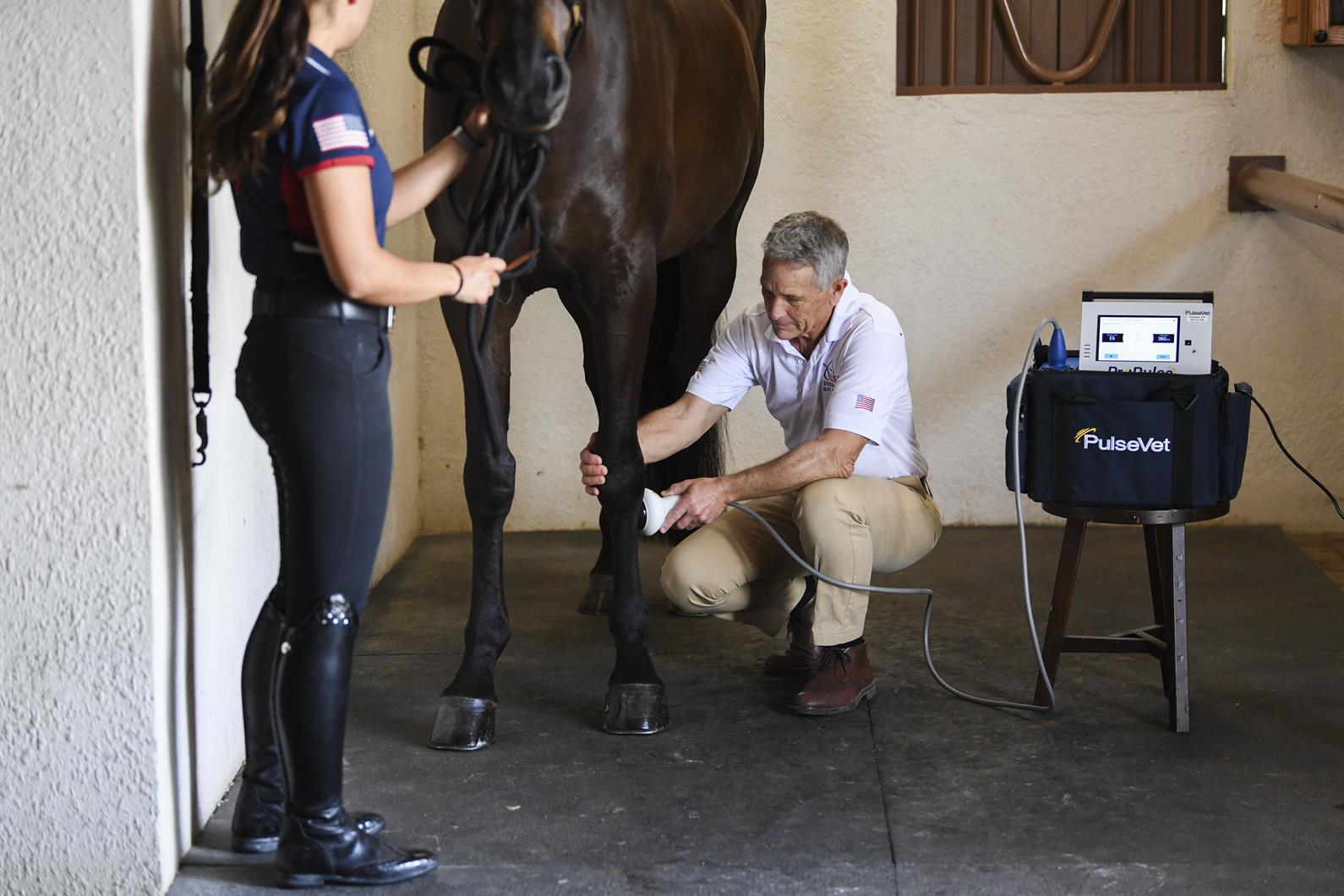
Photo: Courtesy of PulseVet
Can a super-sonic wave of sound energy help your horse heal? There’s evidence that in many situations it can. Dr. Susan Johns, the Land Rover U.S. Eventing Team’s head veterinarian, recently participated in a webinar as one of five veterinarians discussing how they incorporate shock wave therapy into their treatment and rehabilitation of equine athletes.
We asked Dr. Johns, who also is an equine advisory board member for the regenerative veterinary medicine company and electrohydraulic shock wave provider PulseVet, to bring us up to speed on how shock wave therapy works and what conditions it’s best suited to treat.
How does shock wave therapy work?
Shock wave therapy is a super-sonic wave of focused sound energy that pulses through the body. As it passes through cells, it stresses them into releasing healing proteins, which can have positive effects increasing localized blood flow (angiogenesis), modulating inflammation, accelerating bone growth, releasing muscle tension, and providing short-term pain relief.
How is it different from laser therapy?
Shock wave therapy is a type of sound energy, and it travels well through the body. Because laser therapy is a kind of light energy, it dissipates quickly as it travels through the body, so it is limited to treating relatively superficial indications.
It should also be noted that different kinds of shock wave generators are very different from each other. The electrohydraulic method has been most effectively proven for equine sports medicine indications, whereas other types are more specifically designed to treat small, localized problems, such as breaking up kidney stones in human applications (called lithotripsy), so it is very important to understand which type of shock wave generator is being used.
What types of situations or conditions is shock wave therapy best suited to treat?
Shock wave therapy was once considered valuable only when treating serious injuries, but that has changed a lot in the last decade, and now we are routinely seeing shock wave therapy used successfully as part of a maintenance program. At our practice, we use shock wave daily on a wide variety of cases. Shock wave therapy has been proven to improve the quality of healing for tendon and ligament injuries. We also use shock wave to accelerate wound healing. I commonly use shock wave to treat back pathology, including dorsal spinous process impingement (kissing spines) and dorsal articular process inflammation. Shock wave therapy reduces inflammation, increases circulation, and has been shown to slow the progression of arthritis. Focused shock wave therapy is also covered by equine major medical insurance, giving owners some peace of mind that they are electing a proven option.
What is the treatment itself like?
The actual treatment lasts about two to three minutes, with a few minutes for preparation. The treatment is loud and can be uncomfortable, depending on the area being treated, so in some cases a mild sedative might be utilized to ensure the horse’s comfort.
The biological response and healing effect takes place over two to four weeks, and most indications require up to three treatments, two to three weeks apart, to provide optimal benefit. A mild analgesic effect has been shown to last up to four days following the treatment, so it is important that the patient is not overworked during that time period. There are regulations for different equine disciplines concerning administration of shock wave therapy. Trainers and owners should double-check competition rules and inform their veterinarian of upcoming show schedules prior to administering shock wave therapy. Refer to GR414.1 in the Rulebook to understand the rules and restrictions on USEF competitions and the use of shock wave.
Tell us about your most unusual case involving shock wave therapy.
One particular case that stands out to me involves shock waving the poll of a young, up-and-coming event horse. The gelding was displaying avoidance behavior under saddle and had unsteady contact in the bridle. The horse was losing valuable marks during his dressage test. We radiographed the gelding’s neck and poll and diagnosed significant bony remodeling at the external occipital protuberance of the poll. The ultrasound did not indicate a significant bursitis (inflammation of the small, fluid-filled sacs that cushion areas where bone would otherwise rub directly against muscle, tendon, or tissue). We were lucky enough to have a European colleague visiting our practice who told us about a fellow vet in Europe who was shocking this region with success. I remember it clearly, because I was very concerned that the horse would not tolerate this procedure well. We were pleasantly surprised that the procedure was non-invasive and well tolerated. We have now been using shock wave on this region for the past 15 years following this case’s successful outcome.
What are some of the scientific studies that have been done on shock wave therapy, particularly in horses?
There is a wealth of published clinical research showing the efficacy of electro-hydraulic shock wave therapy used for sports medicine indications in the horse (as well as in dogs and humans). There is research from Colorado State University (by Dr. David D. Frisbie, Dr. Chris E. Kawcak, and Dr. C. Wayne McIlwraith) showing benefit for treating osteoarthritis and from Iowa State University (by Dr. Scott McClure) treating navicular disease, chronic wounds, and suspensory ligaments. There is also some interesting newer research from the University of Guelph, Colorado State University, and the University of Georgia showing the benefits of combining shock wave therapy with regenerative medicine, such as stem cell therapy and platelet-rich plasma therapy.


